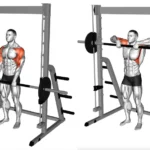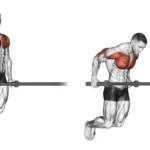Incline Dumbbell Bench Press: Exercise Overview
The incline dumbbell bench press is a highly effective compound exercise designed to target the upper pectoralis major, with secondary engagement of the anterior deltoids and triceps. By performing the press on an incline bench, this variation emphasizes the upper chest, a common lagging area for many lifters, while promoting balanced strength development through unilateral movement.
The use of dumbbells enhances stability and reduces the risk of shoulder and chest injuries compared to barbell presses, making it a versatile choice for chest-focused workouts, push routines, upper-body sessions, or full-body training programs. This exercise supports both aesthetic goals, such as a well-defined chest, and functional strength for pressing movements (Schoenfeld, 2010).
How to Perform the Incline Dumbbell Bench Press
- Set an incline bench to a 30–45-degree angle and select an appropriate pair of dumbbells.
- Using a neutral grip (palms facing inward), pick up the dumbbells and sit on the edge of the bench, resting the ends of the dumbbells on your thighs.
- Lie back on the bench, keeping the dumbbells close to your chest, then rotate your wrists to a pronated grip (palms facing forward) and press the weights to the top position with arms extended—this is your starting position.
- Lower the dumbbells slowly and controlled to chest level, keeping the handles roughly aligned with your chest and elbows at a 45-degree angle from your body.
- Pause briefly at the bottom, then contract your chest to press the dumbbells back to the starting position, stopping just short of full elbow lockout.
- Repeat for the desired number of repetitions.
- To finish: Rotate the dumbbells back to a neutral grip, rest them on your thighs, and use their weight to assist in sitting upright.
Tips for Optimal Performance
- Maintain Chest Tension: Avoid fully locking out your elbows at the top to keep constant tension on the pectorals, enhancing muscle activation (Schoenfeld, 2016).
- Use a 45-Degree Angle: Keep the dumbbells tilted slightly (handles at a 45-degree angle) to maintain neutral elbow positioning and reduce shoulder strain (Escamilla et al., 2009).
- Pinch Shoulder Blades: Retract and depress your shoulder blades throughout the movement to stabilize the shoulders and minimize injury risk (McGill, 2010).
- Control the Movement: Lower and press the dumbbells slowly to maximize time under tension and avoid bouncing or colliding the weights at the top, which can destabilize the shoulders.
- Breathe Properly: Inhale as you lower the dumbbells and exhale as you press them up to support core stability and muscle oxygenation (Wirth et al., 2016).
- Avoid Dropping Dumbbells: Unless using heavy weights and experienced with the technique, safely return the dumbbells to your thighs to avoid shoulder strain or equipment damage.
Targeting your upper chest with incline presses? Discover their place in our Ultimate Guide to Muscle Groups for chest training.







